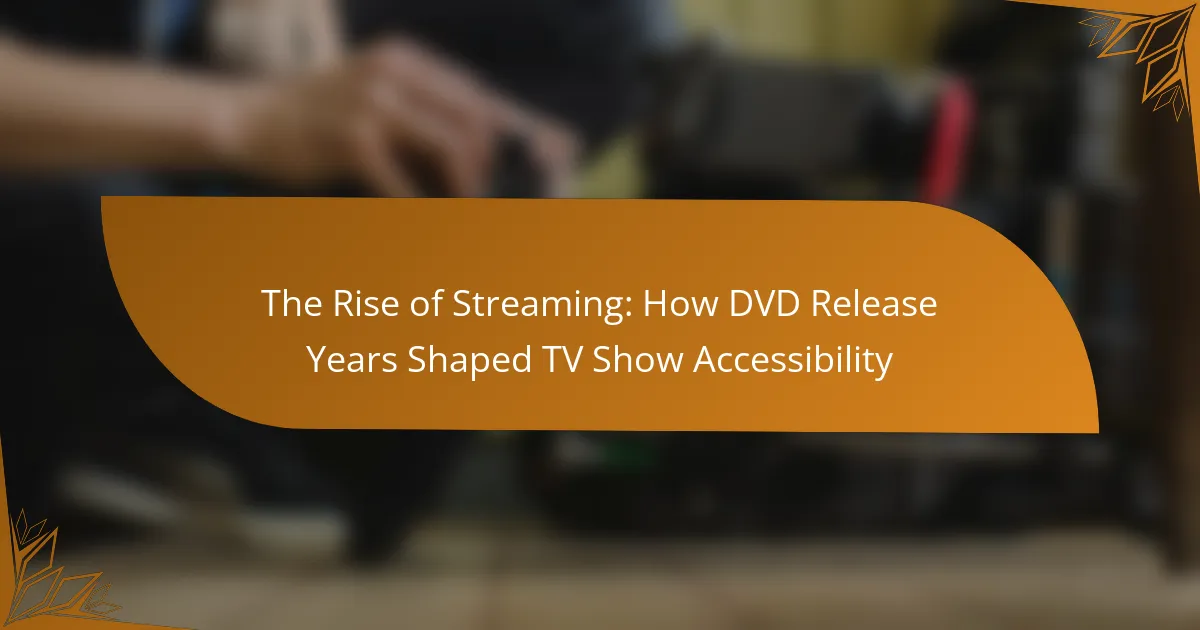The article examines the rise of streaming services, which have revolutionized television show accessibility by allowing viewers to watch content on-demand across various devices. It highlights the significant impact of DVD releases on viewer habits, particularly in promoting binge-watching and increasing show popularity through complete season availability. Key lessons from the DVD era, such as the importance of content availability, timely releases, and exclusive offerings, are discussed in relation to shaping effective streaming strategies. The article emphasizes how these factors have transformed audience engagement with television content and the evolving landscape of media consumption.

What is the Rise of Streaming and Its Impact on TV Show Accessibility?
The rise of streaming refers to the increasing popularity of online platforms that deliver video content directly to viewers. This trend has significantly improved TV show accessibility. Viewers can now watch shows on-demand from various devices. Streaming services like Netflix and Hulu have expanded their libraries, offering a wide range of content. According to a 2021 report by Statista, over 1.1 billion people globally subscribed to streaming services. This shift allows audiences to access shows that may not have been available on traditional cable. Additionally, streaming platforms often release entire seasons at once, enhancing binge-watching experiences. Overall, streaming has transformed how audiences engage with television content.
How did DVD release years influence the availability of TV shows?
DVD release years significantly influenced the availability of TV shows by providing a new medium for distribution. Prior to DVDs, TV shows were often difficult to access after their original airing. The introduction of DVD collections allowed entire seasons of shows to be packaged and sold to consumers. This shift began in the late 1990s and early 2000s, coinciding with the rise of home video consumption.
For example, popular shows like “Friends” and “The X-Files” saw DVD releases that made them widely available for binge-watching. These releases often included bonus content, further enhancing their appeal. As a result, fans could revisit their favorite series at their convenience.
Moreover, the success of DVD sales demonstrated a demand for older shows, leading networks to reconsider their catalog for potential re-releases. This trend paved the way for the future of streaming services, which later capitalized on the established popularity of these DVD collections. Overall, DVD releases expanded the accessibility of TV shows and influenced viewing habits significantly.
What role did DVDs play in the transition from traditional viewing to streaming?
DVDs served as a pivotal bridge between traditional viewing and streaming. They provided a convenient format for home viewing of films and television shows. DVDs offered enhanced audio and visual quality compared to VHS tapes. They also included additional features like behind-the-scenes content and deleted scenes, enriching the viewing experience. The rise of DVD rentals through services like Blockbuster and Netflix popularized at-home viewing. This shift laid the groundwork for the eventual transition to digital streaming. As internet speeds improved, consumers began to favor the immediacy of streaming over physical media. The availability of DVD box sets also encouraged binge-watching, a precursor to streaming habits.
How did the timing of DVD releases affect viewer engagement with shows?
The timing of DVD releases significantly influenced viewer engagement with shows. Early DVD releases allowed audiences to binge-watch series at their own pace. This availability increased viewer interest and retention for shows. For example, popular series like “The Office” saw a surge in viewership after DVD releases. The ability to watch entire seasons contributed to word-of-mouth promotion. This led to higher ratings and renewed interest in subsequent seasons. Research indicates that DVD releases often revitalized older shows, attracting new viewers. Consequently, the timing of DVD releases played a crucial role in shaping viewer engagement and show longevity.
Why is the accessibility of TV shows important in today’s media landscape?
The accessibility of TV shows is crucial in today’s media landscape because it ensures that diverse audiences can engage with content. Increased accessibility allows viewers from various backgrounds to find and enjoy shows that resonate with them. This inclusivity fosters a broader cultural exchange and understanding among different demographics.
Moreover, studies indicate that accessible content can lead to higher viewer engagement. For instance, a report by the Pew Research Center found that 63% of Americans believe access to diverse media positively impacts society. In a streaming era, where competition is fierce, platforms that prioritize accessibility can attract and retain more subscribers.
Additionally, accessibility features, such as subtitles and audio descriptions, cater to individuals with disabilities. This compliance with accessibility standards not only enhances user experience but also expands the potential audience base. As a result, the importance of accessibility in TV shows is underscored by its role in promoting inclusivity, enhancing engagement, and ensuring compliance with societal standards.
What factors contribute to the demand for accessible TV show content?
The demand for accessible TV show content is driven by several key factors. First, increasing awareness of disability rights has heightened the need for inclusivity. This has led to more advocacy for accessible media options. Second, advancements in technology have made it easier to provide features like closed captioning and audio descriptions. Third, the growing diversity of audiences has created a larger market for content that caters to various needs. According to a 2021 report by the National Association of Broadcasters, 78% of viewers prefer shows that offer accessibility features. Additionally, regulatory requirements in many regions mandate accessibility in broadcasting. These factors collectively contribute to a significant rise in demand for accessible TV show content.
How do streaming services cater to diverse audience needs?
Streaming services cater to diverse audience needs by offering a wide range of content options. They provide various genres, including drama, comedy, and documentaries. Many platforms also feature international films and shows to appeal to global audiences. Customizable user interfaces allow viewers to create personalized profiles. These profiles can recommend content based on viewing history and preferences. Additionally, streaming services often include accessibility features, such as subtitles and audio descriptions. According to a 2021 report by Deloitte, 80% of users value personalized recommendations. This shows the effectiveness of these strategies in meeting diverse needs.

How Did DVD Release Years Shape Viewer Habits?
DVD release years significantly influenced viewer habits by providing convenient access to television shows. The introduction of DVDs allowed consumers to watch entire seasons at their own pace. This shift encouraged binge-watching, a behavior that became prevalent in the 2000s.
Before DVDs, viewers were limited to weekly episodes. The availability of complete seasons on DVD changed this dynamic. Statistics show that shows released on DVD saw increased viewership and renewed interest. For example, “The Office” experienced a surge in popularity after its DVD release, leading to higher ratings in subsequent seasons.
Additionally, the ability to own physical copies of shows fostered a collector’s mentality among fans. This created a new market for television series, leading to more extensive merchandising opportunities. Overall, DVD release years played a crucial role in shaping modern viewing habits and preferences.
What trends emerged from the release of TV shows on DVD?
The release of TV shows on DVD led to several notable trends. One significant trend was the increased demand for complete series box sets. Consumers preferred to purchase entire seasons rather than individual episodes. This shift encouraged studios to invest in comprehensive packaging and marketing strategies.
Another trend was the rise of special features and bonus content. DVDs often included behind-the-scenes footage, commentary, and interviews, enhancing viewer engagement. This additional content became a selling point for many releases.
Additionally, the DVD format allowed for improved accessibility of older shows. Many classic series that were previously difficult to find became readily available. This accessibility contributed to a resurgence in interest for nostalgic programming.
The release of TV shows on DVD also influenced viewing habits. Audiences began binge-watching entire seasons at once, changing the landscape of television consumption. This trend paved the way for future streaming services that cater to binge-watching preferences.
Overall, the DVD release of TV shows transformed the market, shaping consumer behavior and paving the way for digital streaming platforms.
How did DVD box sets change the way audiences consumed TV shows?
DVD box sets transformed audience consumption of TV shows by offering complete seasons for home viewing. This change allowed viewers to binge-watch entire series at their own pace. Prior to DVD box sets, audiences typically watched episodes weekly on television. The availability of box sets encouraged fans to revisit favorite shows and discover older series. According to a 2005 study by the Pew Research Center, 30% of Americans reported watching more TV due to DVD availability. Additionally, DVD box sets often included special features, enhancing the viewing experience. This shift laid the groundwork for the later rise of streaming services. Streaming further capitalized on the binge-watching trend initiated by DVD box sets.
What impact did DVD special features have on viewer experience?
DVD special features significantly enhanced viewer experience by providing additional content that deepened engagement with the film or series. These features often included behind-the-scenes footage, director commentaries, and deleted scenes. This extra content allowed viewers to gain insights into the filmmaking process. It also fostered a greater appreciation for the narrative and characters. According to a survey by the Digital Entertainment Group, 70% of consumers reported that special features influenced their decision to purchase DVDs. The availability of such content created a more immersive experience, making viewers feel more connected to the material. Furthermore, these features often sparked discussions among fans, enhancing community engagement. Overall, DVD special features transformed passive viewing into an interactive experience.
How did the timing of DVD releases correlate with the rise of streaming?
The timing of DVD releases significantly correlated with the rise of streaming services. DVD releases often preceded streaming availability by several months to years. For example, popular series like “Friends” had DVD box sets released in 2005, while streaming platforms gained traction around the same time. This created a demand for content that streaming services later capitalized on. As DVD sales peaked in the mid-2000s, streaming platforms began to emerge, offering instant access to similar content. By 2010, services like Netflix transitioned from DVD rentals to streaming, reflecting changing consumer preferences. The overlap in release timing influenced viewer habits, driving subscriptions to streaming services for immediate access.
What key events marked the transition from DVD to streaming services?
The transition from DVD to streaming services was marked by several key events. The launch of Netflix’s streaming service in 2007 was pivotal. This shift allowed subscribers to watch content instantly without physical media. In 2010, the release of the first major streaming-only series, “House of Cards,” showcased the potential of original content. The increasing availability of high-speed internet facilitated broader access to streaming platforms. By 2012, streaming surpassed DVD rentals in revenue, highlighting a significant consumer shift. Additionally, major studios began to create their own streaming services, such as HBO Go in 2010. The decline in DVD sales further indicated the changing landscape of media consumption. These events collectively illustrate the industry’s evolution towards streaming as the primary method of content delivery.
How did DVD sales influence the content available on streaming platforms?
DVD sales significantly influenced the content available on streaming platforms. The popularity of DVDs drove demand for specific titles and genres. This demand led content creators to prioritize these popular shows when negotiating streaming rights. As a result, streaming platforms built their libraries around successful DVD sales. For instance, shows with strong DVD sales often received early streaming releases. Historical data indicates that titles like “Friends” and “The Office” saw increased streaming availability due to their DVD success. The trend established a connection between physical media sales and digital content offerings. Thus, DVD sales shaped the strategic decisions of streaming services regarding content acquisition.

What Lessons Can Be Learned from the DVD Era for Future Streaming Strategies?
The DVD era teaches valuable lessons for future streaming strategies. One key lesson is the importance of content availability. During the DVD era, limited releases often frustrated consumers. Streaming platforms should ensure a broad library to avoid similar dissatisfaction. Another lesson is the significance of timing. DVDs frequently released seasons long after airing. Timely releases on streaming can enhance viewer engagement and satisfaction. The DVD era also highlighted the value of bonus content. Extras like behind-the-scenes footage attracted buyers. Streaming services can replicate this by offering exclusive content. Lastly, consumer behavior data from DVD sales can inform streaming strategies. Analyzing which titles sold best can guide content acquisition. These lessons underline the need for accessibility, timing, exclusive offerings, and data-driven decisions in streaming.
What best practices can content creators adopt from the DVD release model?
Content creators can adopt several best practices from the DVD release model. First, they should consider staggered releases to build anticipation. This approach creates excitement and encourages audience engagement over time. Second, including bonus content enhances the value of the release. Behind-the-scenes footage and interviews can deepen viewer connection. Third, creating themed collections can attract niche audiences. Bundling related content appeals to specific viewer interests. Fourth, offering limited editions can drive urgency and exclusivity. This strategy can boost sales and fan loyalty. Finally, leveraging user feedback for future releases can improve content quality. Engaging with audience preferences leads to more successful projects. These practices have historically contributed to the success of DVD sales and can be effectively applied in today’s digital landscape.
How can understanding DVD release trends improve streaming service offerings?
Understanding DVD release trends can enhance streaming service offerings by informing content acquisition strategies. Streaming platforms can analyze which titles have historically performed well on DVD. This analysis helps identify viewer preferences and demand for specific genres or series. For instance, popular shows released on DVD often indicate a strong fan base. By acquiring similar titles, streaming services can attract more subscribers. Additionally, trends in DVD release schedules can signal when to launch new seasons or related content. This timing can maximize viewer engagement and retention. Historical data shows that shows with successful DVD sales often have a second life on streaming platforms. Thus, leveraging these insights can lead to better programming decisions and increased viewer satisfaction.
What strategies can enhance viewer retention based on past DVD success?
Offering exclusive content can enhance viewer retention based on past DVD success. Special features, such as behind-the-scenes footage and commentary, engage viewers. High-quality packaging and collectible items also attract interest. Creating limited edition releases encourages urgency and exclusivity. Bundling seasons together can provide value and convenience for viewers. Interactive elements like quizzes and games can enhance viewer experience. Marketing campaigns that emphasize nostalgia can draw in past fans. The success of DVD series like “Friends” shows the effectiveness of these strategies in maintaining viewer interest.
How can viewers maximize their TV show accessibility in the streaming age?
Viewers can maximize their TV show accessibility in the streaming age by utilizing multiple streaming platforms. Each platform offers unique content libraries. Subscribing to various services expands viewing options significantly. Viewers should also take advantage of free trials to explore different libraries. Using search tools helps locate specific shows across platforms. Enabling subtitles or closed captions enhances understanding. Scheduling viewing times can ensure consistency in watching. Finally, engaging in online communities can provide recommendations and tips for accessibility.
What tools and resources are available for finding TV shows across platforms?
Streaming platforms offer various tools and resources for finding TV shows. Popular services include JustWatch, Reelgood, and Can I Stream It. These platforms allow users to search for shows across multiple streaming services. They provide information on availability, pricing, and where to watch specific titles. Users can filter results by genre, release year, and user ratings. Additionally, many streaming services have built-in search functions. These features enhance the user experience by simplifying the discovery process. Data from these tools is updated regularly to reflect changes in streaming availability.
How can viewers stay informed about new releases and accessibility options?
Viewers can stay informed about new releases and accessibility options by subscribing to streaming service newsletters. These newsletters often provide updates on upcoming content and features. Additionally, following social media accounts of streaming platforms can offer real-time announcements. Websites dedicated to entertainment news also regularly report on new releases and accessibility features. Forums and community groups focused on specific shows can share insights and updates. Lastly, utilizing apps that track streaming releases can help viewers stay organized and informed.
The main entity of the article is the rise of streaming and its impact on TV show accessibility, particularly influenced by DVD release years. The article explores how streaming platforms have transformed viewer engagement by providing on-demand access to a wide array of content, enhancing binge-watching experiences, and expanding the availability of shows that were previously hard to find. It also examines the role of DVD releases in shaping viewing habits, the importance of accessibility in today’s media landscape, and the strategies that streaming services can adopt based on lessons learned from the DVD era. Key factors driving demand for accessible content and the tools available for viewers to maximize their TV show accessibility are also discussed.


